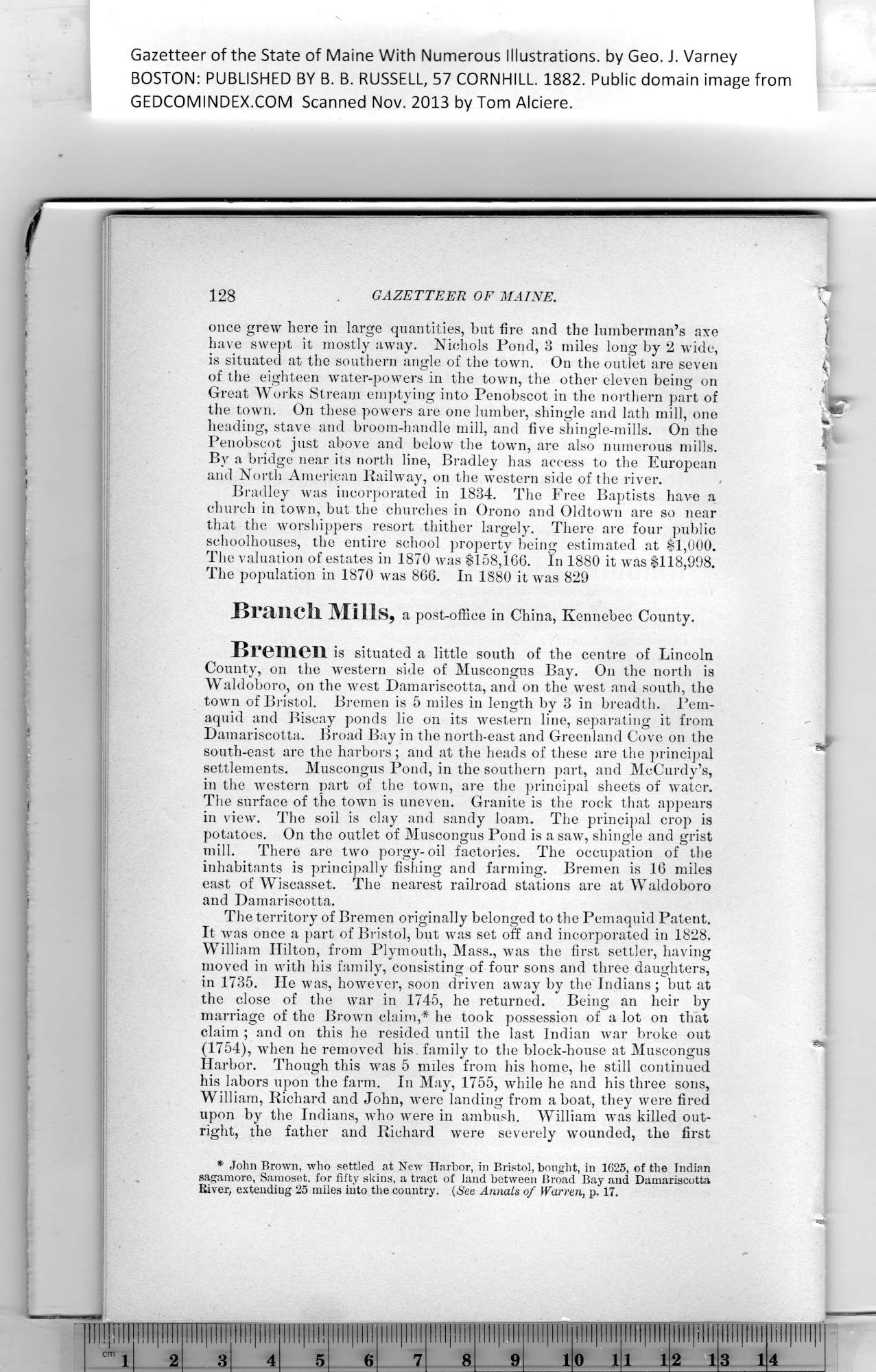|
Gazetteer of the State of Maine With Numerous Illustrations, by Geo. J. Varney
BOSTON: PUBLISHED BY B. B. RUSSELL, 57 CORNHILL. 1882. Public domain image from
128 GAZETTEER OF MAINE.
once grew here in large quantities, but fire and the lumberman’s axe
have swept it mostly away. Nichols Pond, 3 miles long by 2 wide,
is situated at the southern angle of the town. On the outlet are seven
of the eighteen water-powers in the town, the other eleven being on
Great Works Stream emptying into Penobscot in the northern part of }
the town. On these powers are one lumber, shingle and lath mill, one
beading, stave aud broom-handle mill, and five shingle-rnills. On the
Penobscot just above and below the town, are also numerous mills.
By a bridge near its north line, Bradley has access to the European
and North American Railway, on the western side of the river.
Bradley was incorporated in 1834. The Free Baptists have a
church iu town, but the churches in Orono and Oldtown are so near
that the worshippers resort thither largely. There are four public
schoolhouses, the entire school property being estimated at $1,000.
The valuation of estates in 1870 was $158,166. In 1880 it was $118,998.
The population in 1870 was 866. In 1880 it was 829
Branch Mills, a post-office in China, Kennebec County.
Bremen is situated a little south of the centre of Lincoln
County, on the western side of Muscongus Bay. On the north is
Waldoboro, on the west Damariscotta, and on the west and south, the
town of Bristol. Bremen is 5 miles in length by 3 in breadth. Pem-
aquid and Biscay ponds lie on its western line, separating it from
Damariscotta. Broad Bay in the north-east and Greenland Cove on the
south-east are the harbors; and at the heads of these are the principal
settlements. Muscongus Pond, in the southern part, and McCurdy’s,
in the western part of the town, are the principal sheets of water.
The surface of the town is uneven. Granite is the rock that appears
in view. The soil is clay and sandy loam. The principal crop is
potatoes. On the outlet of Muscongus Pond is a saw, shingle and grist
mill. There are two porgy-oil factories. The occupation of the
inhabitants is principally fishing and farming. Bremen is 16 miles
east of Wiscasset. The nearest railroad stations are at Waldoboro
and Damariscotta.
The territory of Bremen originally belonged to the Pemaquid Patent.
It was once a part of Bristol, but was set off and incorporated in 1828.
William Hilton, from Plymouth, Mass., was the first settler, having
moved in with his family, consisting of four sons and three daughters,
in 1735. He was, however, soon driven away by the Indians ; but at
the close of the war in 1745, he returned. Being an heir by
marriage of the Brown claim,1 he took possession of a lot on that
claim ; and on this he resided until the last Indian war broke out
(1754), when he removed his. family to the block-house at Muscongus
Harbor. Though this was 5 miles from his home, he still continued
his labors upon the farm. In May, 1755, while he and his three sons,
William, Richard and John, were landing from a boat, they were fired
upon by the Indians, who were in ambush. William was killed out-
right, the father and Richard were severely w'ounded, the first
1
John Brown, who settled at New Harbor, in Bristol, bought, in 1625, of the Indian
sagamore, Samoset, for fifty skins, a tract of land between Broad Bay and Damariscotta
River, extending 25 miles iiito the country. {See Annals of Warren, p. 17.
PREVIOUS PAGE ... NEXT PAGE
This page was written in HTML using a program written in Python 3.2
|
